by Curtis Kuo & Victoria Gomez | Dec 16, 2021
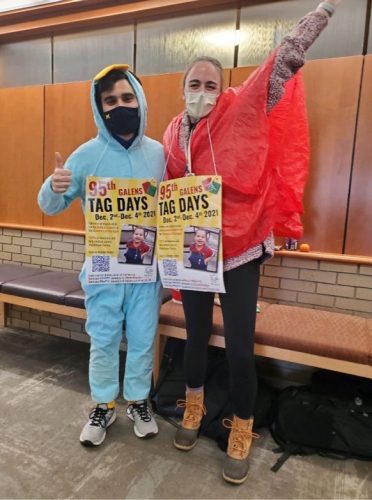
M1 Cyrus and M2 Kayla tagging together during a shift on Thursday in the hospital
As a medical student here at the University of Michigan there are plenty of ways that we can give back to our community. From Wolverine Street Medicine, a group that provides healthcare to the homeless, to UMAC, a group that advocates for survivors of human rights abuses, to the dedicated students who run our Student-Run Free Clinic – helping others is in our blood. However – I might be a bit biased, but – no other event combines giving back to our community with as much fun, holiday cheer, and wacky tradition as Galens Tag Days.
What is Galens Tag Days, you ask? Tag Days is a large-scale fundraiser for children’s charities and organizations in our local county. Every year, medical students disperse throughout the hospital and the city wearing red ponchos and silly onesies. Looking like this, it’s hard for passersby to ignore our charming requests – and when they learn about our mission and the organizations we support, the donations come rolling in!
Every year, we raise tens of thousands of dollars in small donations from generous Ann Arbor supporters, and in exchange they receive a fashionable red, green or *maize* tag that they can tie to their coat zipper or dog’s collar! Due to the Covid-19 pandemic, our yearly fundraiser was moved entirely online in 2020, so we were especially excited to be back in person this year!
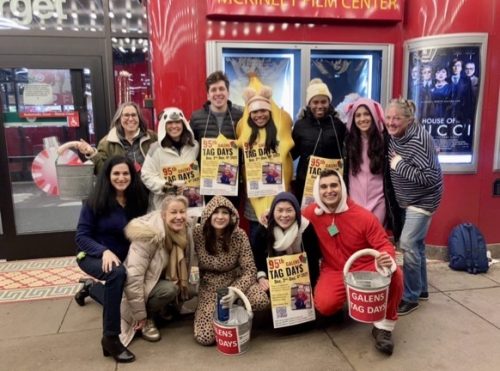
Can you tell the faculty apart from the students in this picture snapped during Midnight Madness on Friday in downtown Ann Arbor?
In addition to supporting a great cause (For The Kids! is the slogan of Tag Days), there are other compelling reasons for medical students to get involved in this event. Our incredible medical school faculty and staff drive around the town in “Happy Vans” or pull a “Happy Wagon” around the hospital, distributing snacks and beverages to warm our bodies and spirits during our cold shifts outside. It certainly makes our attendings less intimidating on the wards after we’ve played several rounds of chubby bunny with them outside the hospital.
Some faculty combinations have been going strong for years, and the competition between rival vans is real (I won’t name names, but this year there might have been a legendary van theft in the middle of a shift!) Happy Van Drivers include head of the pulmonary sequence for M1 students, transplant surgeons, and our very own Dean for Student Services, and it’s so special to get to know them in this unique context.
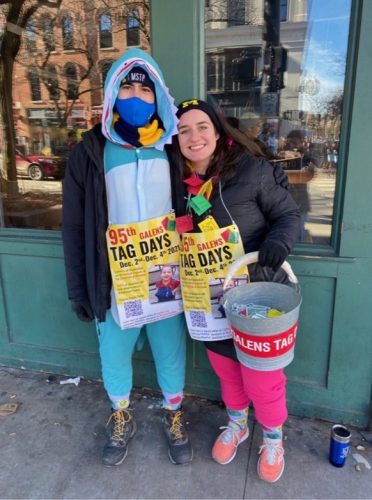
M3 Aaron and M2 Dana raising money For The Kids! on Saturday morning
In addition to creating lasting memories with your med school best friends, Tag Days also allows you another opportunity to get to know students in other classes. As an M1, sharing a tagging experience with an M4 can create a lifelong connection with a future IM physician at Penn or OB/GYN at Northwestern (speaking from experience here!)
So – we have an excuse to break away from UWorld, support a great cause, get to authentically know attendings and build friendships and memories across the medical school – what’s not to love?
Although Tag Days 2021 is behind us (**online donations still accepted through December, details below), the most exciting part of this tradition is just around the corner! In January and February, we will allocate the funds raised during Tag Days 2020. That means we have the responsibility and privilege of distributing the nearly $80,000 that was raised last year!
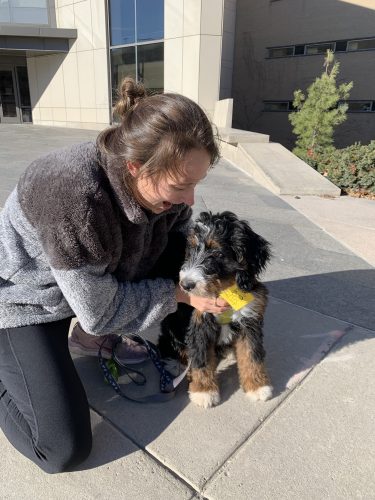
Any puppy looks so much cuter with a Galens Tag hanging from their harness!
Organizations we have funded in the past include Girls Group, Children’s Literacy Network, Student Advocacy Center, and the Leslie Science and Nature Center, and some of the projects and events we helped fund can be found on our Instagram page. Stay tuned to see where this year’s donations will go!
**Interested in supporting Tag Days? Donations can be made online at https://www.gofundme.com/f/tagdays2021 or you can Venmo us @GalensTagDays. We’re getting close to our goal and every donation helps!
by Alana Slavin | Nov 12, 2021
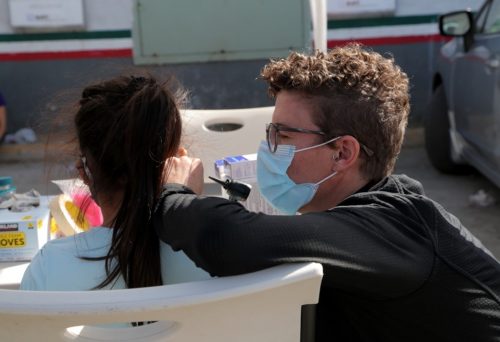
Dr. Hannah Janeway, ED physician and founder of Refugee Health Alliance (https://www.refugeehealthalliance.org/), provides medical care to a patient in the El Chaparral asylum-seeker camp in Tijuana, Mexico. Photo by Lisbeth Chavez (https://www.lisbethchavez.com/).
Thousands of tents lined the crowded streets. The sun was rising slowly on the horizon. At the end of the street stood a large white tent, hovering above the others. A physician and nurse sat in the shade that the tent provided. Quickly, hundreds of people began to line up in front of the tent, waiting to be seen by the health care providers. The doctor handed the coughing children honey, a rare treat that trickled down their lips and stuck to their hands. The children ran around the tent that we had set up, clinging onto my stethoscope and Physicians for Human Rights (PHR) badge. As I worked closely with Dr. Janeway to provide care to those seeking asylum at the border, I felt truly grateful to be a medical student at the University of Michigan.
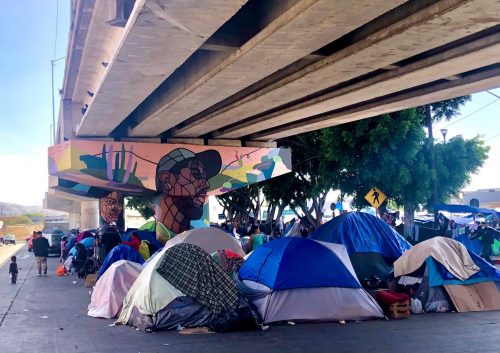
Tents line the streets at the El Chaparral asylum-seeker camp in Tijuana, Mexico.
As a medical school applicant, I was drawn to the University of Michigan Medical School due to the wide array of opportunities for students to participate in volunteer activities and advocacy efforts. At Michigan, students are given many opportunities to explore advocacy both within the confines of Michigan Medicine and beyond. The school truly understands the importance of training the future generation of physician advocates.
Given my interest in advocating for immigrants, refugees, and asylum-seekers, I dove into advocacy opportunities my first year as a medical student by joining the Physicians for Human Rights student chapter, also known as the University of Michigan Asylum Collaborative. Specifically, I served as the Co-Executive Director of the Asylum Collaborative during my first year of medical school. During my first and second year of medical school, I also collaborated with attendings and other students in providing forensic evaluations for asylum-seekers; such evaluations document the physical and mental health effects of trauma endured by asylum-seekers and are subsequently used as an informative document in their asylum claims. During my first year, I also served a student leader in other student organizations, such as the Co-Community Engagement Director for the Health Equity Scholar’s Program (HESP).
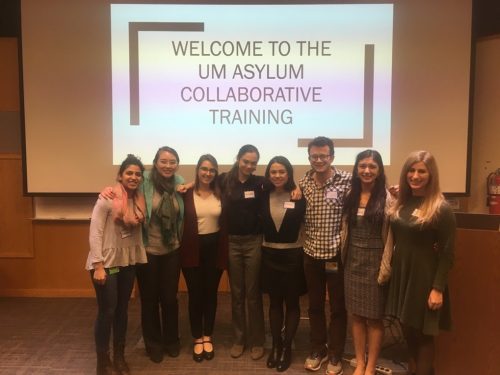
Members of the 2018-2019 University of Michigan Asylum Collaborative (UMAC) Executive Board hosts a forensic evaluation training session for faculty and students at the University of Michigan
During my third year of medical school, I wanted to further explore the role of advocacy at the intersection of clinical care and research. I applied for an internship position with Physicians for Human Rights. As a Medical Student Intern, I helped develop and implement a research project to evaluate the mental health impact of family separation and expulsion among asylum-seekers in Mexico. The experience, particularly interviewing asylum-seekers in Tijuana and Ciudad Juarez, Mexico, granted a holistic picture of how the asylum process intersects with mental health. Our team then used these findings to generate a report for Physicians for Human Rights, titled “Neither Safety Nor Health: How Title 42 Expulsions Harm Health and Violate Rights.” This report was used to guide key advocacy efforts, such as in the creation of a letter to the CDC – signed by 1,383 medical professionals – requesting that the CDC reverse the Title 42 expulsions order at the US-Mexico Border. Our research was also referenced in recent media coverage by organizations such as Amnesty International, Mother Jones, and more. This opportunity was made possible through Michigan Medicine’s unwavering support, ranging from the support of amazing faculty, such as Dr. Michelle Heisler, to funding for the project via the Capstone For Impact Project grant.
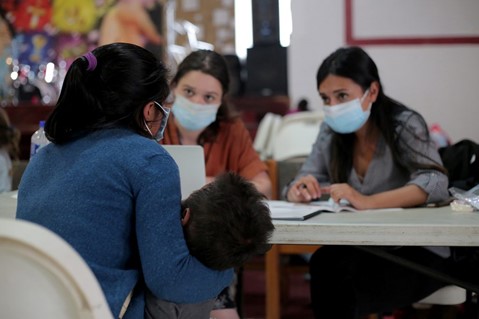
PHR representative Cynthia Pompa (right) and I interview a 22-year-old mother from Guatemala who was seeking asylum for herself and her children. Photograph by Lisbeth Chavez (https://www.lisbethchavez.com/).
Now, I am a fourth-year medical student applying to psychiatry residency. In the future, I hope to serve as a psychiatrist who advocates on behalf of immigrants, refugees, and asylum-seekers. Pursuing training at Michigan Medicine fostered my interest in pursuing justice in the field of mental health. The opportunity to pursue such a diverse array of electives during my M3 and M4 year was critical in allowing me to get “on the ground” experience. Furthermore, having incredible mentors who supported my vision for advocacy – such as Dr. Michele Heisler — was critical in my success. I truly believe that pursuing my medical education at the University of Michigan granted me the skills and vision to serve as an effective advocate.
by Rebekah Sugarman | Oct 29, 2021
When I first considered medical school, I knew nothing about what I was getting myself into. I was a senior in high school ready to go halfway across the country to attend college. I really loved to travel, play volleyball, and play the cello. I also loved biology and somehow, I really don’t remember exactly what did it, I settled on medicine as a future career. I had no idea what was in store. My parents were both teachers, and they encouraged education in its highest form, but I didn’t have any role models in medicine growing up. My uncle is a physician, as are a few of my cousins, but they lived far away and I didn’t know much about what they did on a day-to-day basis. Some of my friends’ parents were doctors, but I didn’t understand or know enough to ask questions about what their lives looked like. All I knew was medicine could be a way to help make people’s lives better. I went off to college assuming I would figure it out at some point.
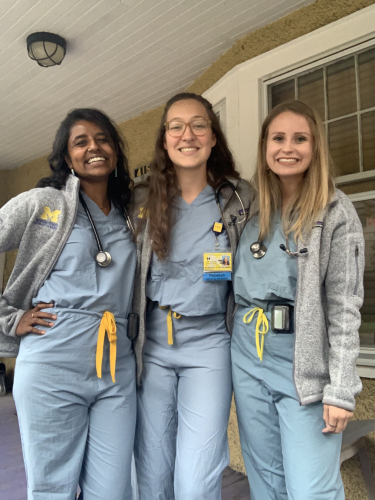
My roommates and I (center) on our first day of clinical year, trying on our new scrubs.
In college, premedical students were many and opportunities were few. Due to my interest in global health, I joined the International Studies major and was set off on a premedical track for non-STEM majors. I loved my classes, but I was mostly disconnected from other students considering medicine. I read online about how to get into medical school and realized I was woefully behind on experiences, so I tried to shadow or find research opportunities. When I tried to apply for an opportunity to shadow, I was rejected due to my lack of prior experience. When I looked into mentoring, I was greeted with wonderful premedical advisors but a paucity of current medical students and residents to talk to about their experiences. I left college with many more questions, hoping I would find some answers in medical school.
It is no secret that prospective medical students who don’t come from physician families are at a disadvantage. In 2015, the American Medical Association estimated that 1 in 5 medical students has a parent that is a physician. Besides financial advantage, having physicians in the family gives prospective students more opportunity to shadow, find research, and engage with the profession earlier than others. There is a resource to ask questions and create connections, as well as someone to bounce ideas off of when considering medical school. When I thought of medicine, all I had to go on was TV shows like Grey’s Anatomy and House, hyper-realistic portrayals of a profession filled with danger, drama, and intrigue. I knew little of the reality I would find in medical school.
At the University of Michigan Medical School, we are given so many opportunities to find ourselves in the clinical setting, interacting with real patients and providers. The school understands this differential that exists between those with and without doctors in their families, and they strive to close that gap with early programming and clinical experiences. A lot of my early exposure came from individuals that weren’t physicians. For example, as part of the Interprofessional Clinical Experience (now Interprofessional Collaborative Skills – ICS), I shadowed a social worker for a day of family meetings, getting to interact with patients and their loved ones during the hardest moments of their lives. I got to follow a patient advocate as they visited teenagers during chemotherapy, providing companionship, checking in on them, and answering questions about care. As I followed these professionals through the winding, confusing maze of the hospital I could finally see myself in these halls. I could see myself providing care to these patients one day, because now I knew what it might look like.
I also participated in the Clinical Reasoning Elective (CRE) as an M1. This experience allows first-year students to practice their clinical interviewing skills in pairs with support from a faculty mentor. Due to COVID-19, I only ended up completing one shift of the elective, but it was a memorable one. It was my first time in an emergency department, and it was a very busy day, full of trauma patients and beds lined up in the hallways. I was caught in the middle of a storm, overwhelmed by all the activity around me and unsure how to find my place in it all. In a valiant attempt to make me feel useful, my preceptor convinced me it was crucial to go into a patient’s room to listen to a heart murmur and ask about their medical history. I stood outside the door in the hallway for 15 minutes working up the courage to go inside, and once I made it in I spent 20 minutes stumbling over my words and embarrassing myself. Later, debriefing with my preceptor, I realized I had done a patient interview for the first time on a real patient. I was finally learning what life might be like as a physician.
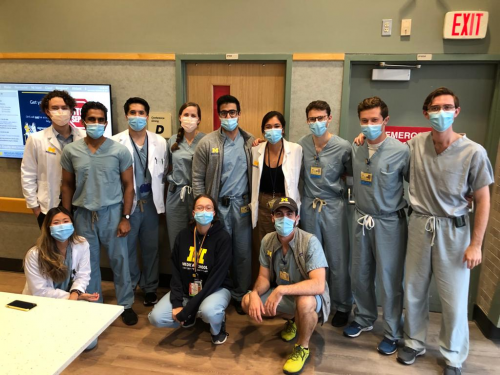
My track on the last day of clinical year (Track G!)
Now, I am an M3 and have just finished my M2 clinical year, a whirlwind of patient care in hospitals and clinics around Ann Arbor. I have assisted with 8-hour long surgeries, delivered babies, diagnosed illness, counseled patients on lifestyle or dietary changes, and participated in so many lifechanging moments. This morning I walked into my first clinical day as an M3 and felt confident – I knew how to use our electronic medical record, I knew how to navigate the halls of the hospital, and I walked right in a patient’s room, after knocking of course. I am well on my way to becoming a physician that the high school version of myself would have not thought possible.
As a prospective student, it is okay to be overwhelmed and have a million unanswered questions. Here at Michigan, you will find the answers through early patient interaction, experience in the hospital, and clinical role models everywhere you turn. You will be part of a supportive, diverse community looking to lift each other up and full of career-changers, non-STEM majors, and those who had never known a single person in the health care field. You will find success through programs like the ICS and CRE, and you will one day find yourself as a mentor to premedical students that were in your shoes not too long ago.
by Kristin Geczi | Oct 7, 2021
I have been painting, drawing, creating art for as long as I can remember. When I was a kid and needed an activity to do, my mom would provide me with art supplies. Now, as an adult, painting is how I unwind, relax, and reflect.
I just finished my M2 year, the clerkship year with patient care experience in the hospital. My days ranged from helping drive a camera for laparoscopic gall bladder removal to holding the hand of a neurology patient as he received care in the neuro ICU to attempting to examine a squirming toddler who was making it very clear that the last place she wanted to be was the pediatrician’s office. I saw patients on labor and delivery experience immense joy when their children were born, and I met patients and families on some of the hardest days of their lives in the emergency department.
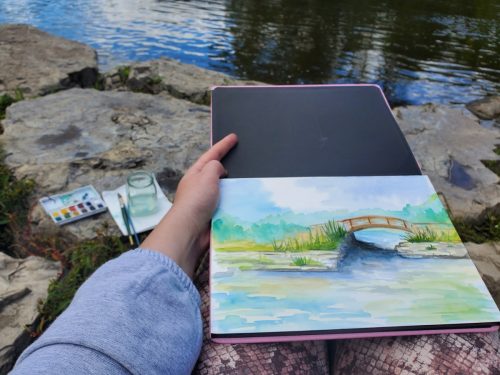
I celebrated the end of clinical year painting by the Argo Cascades, a short walk from my apartment. People floating down the river in inner tubes passed by me as well as several ducks.
I loved the busyness of the hospital and connecting with my patients and families, but I also had some long hours and emotionally hard days. I needed some time to turn off my clinical brain and just paint. Painting gave me the space to process the variety of experiences I had during my second year of medical school. One of the reasons I felt that the University of Michigan was the best fit for me for medical school was how supportive they were of my other interests outside of medicine such as painting.
M1 year, I joined a student organization called the M-Home Peer Support Advocacy. It was founded by my friend Claire Collins (M4) when she saw a need for a student-run organization focusing on the mental health and wellbeing of medical students. In one of our meetings at the end of M2 year, I realized that I wanted to give my peers a chance to have the peaceful, relaxing experience of creating art amidst the flurry of fall activity around the medical school. With the help of my Peer Support colleagues, I planned a painting workshop and partnered with M-Home, a medical school organization for student support.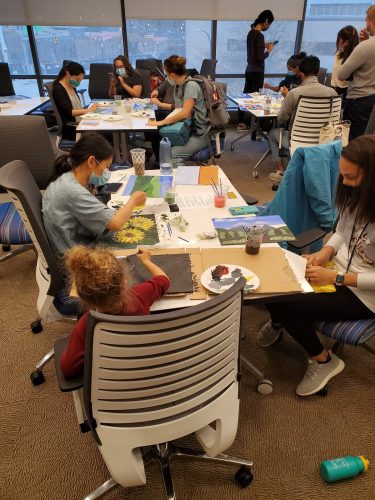
I planned a landscape that I thought would be accessible to students of any or no painting experience. My roommate was kind enough to let me pilot the instructions with her before I opened signups for the fall painting class. Thirty-five students attended my painting session held in the Taubman Health Sciences Library. I was grateful for the chance to meet some of the students in the M1 and M2 classes. Due to the Covid pandemic, I hadn’t had much of a chance to meet many of my colleagues in other classes.
My favorite part of the painting class was that, in the beginning, almost everyone was following my instruction and by the end most people didn’t need to. From the outset, I wanted everyone to take ownership of their paintings and stated that no one had to follow my instructions. Most of my classmates ended up painting landscapes, and they all looked different because everyone began making different creative decisions. Students from all classes bonded over making art in just an hour-long session. More importantly, on a chilly, rainy October evening, a classroom in THSL was filled with conversation, creativity, and community.

Medical students hard at work creating art! This was towards the end of the session when everyone was putting the finishing touches on their works.
by Sangini Tolia | Sep 16, 2021
A few months ago, my friend Lisa Chionis (M2) messaged Morgan Bradford (M2) and me with a link to an Instagram post by @foodgatherers asking for volunteers at their annual Farm Project. The three of us had been working together on a culinary medicine elective for the past year, but because of the pandemic, we had never actually met each other in person. Volunteering at a farm sounded like a perfect way to finally spend an afternoon “in real life” together!
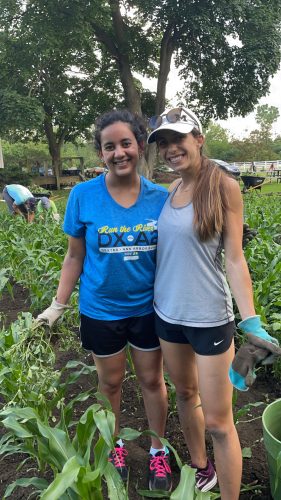
With Lisa Chionis, M2 (right), in our freshly weeded rows of corn on a beautiful day!
Food Gatherers is a local food bank and food rescue program in Washtenaw County, where Ann Arbor is located. The Farm Project is a collaboration between Food Gatherers, the Mindful Eating Coalition, and Bill Schmid (“Farmer Bill”), who volunteers his property as a space to grow fresh produce. Most of the produce is donated directly to Food Gatherers, and some produce is sold at his roadside stand to raise money for an additional cash donation. The project is run entirely by volunteers who plant seeds, weed, mulch, water, and harvest the crops!
On our first day, Lisa, Morgan and I showed up and got right to work on weeding the patch of corn together. As we made our way up and down the rows, we soon realized that we were the youngest volunteers there (probably by at least 20 to 30 years)! Despite the age gap, we felt right at home and had an incredible afternoon together.
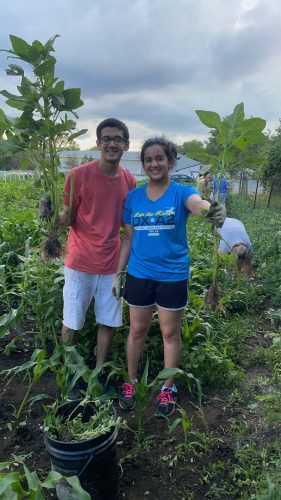 Over the summer, I kept coming back to volunteer about once a week at the farm. My brother, an undergraduate at Michigan, also started joining me regularly, and this became our usual Monday evening ritual. I loved that we had this time to hang out with each other in the middle of our busy schedules. I also had a lot of fun getting to know the other “regulars” volunteering. We’d all swap stories about our lives, and I particularly loved hearing the ones about their grandkids’ latest shenanigans!
Over the summer, I kept coming back to volunteer about once a week at the farm. My brother, an undergraduate at Michigan, also started joining me regularly, and this became our usual Monday evening ritual. I loved that we had this time to hang out with each other in the middle of our busy schedules. I also had a lot of fun getting to know the other “regulars” volunteering. We’d all swap stories about our lives, and I particularly loved hearing the ones about their grandkids’ latest shenanigans!
The last few months of my M4 year have been quite busy. I recently completed rotations in Hematology/Oncology and the ICU, and I’m now studying for my emergency medicine shelf exam and writing my residency applications. At the end of a long day, it has been so rejuvenating to take a break and spend a few hours volunteering outside in the sunshine and fresh air. There’s something so therapeutic about getting down in the dirt and plucking out those pesky weeds. Plus, you wouldn’t believe what a great full-body workout gardening can be with all the lifting and squatting! Week by week, the little seedlings that we planted in May took root and sprouted into magnificent stalks of corn, huge heads of cabbage, and all kinds of juicy tomatoes. I felt amazed by how much growth had taken place every week!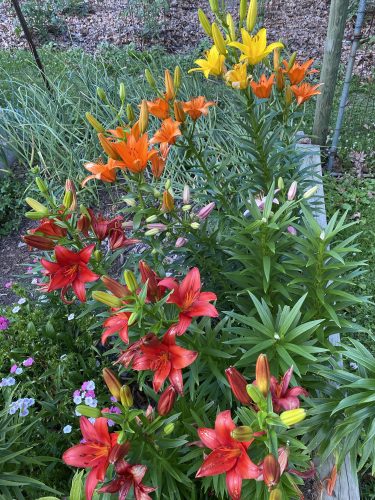
I’ve really loved my time at the Farm this summer. I encourage you to continue your hobbies and the things that “nourish” you while in medical school. I found it quite special to be able to combine my interests in gardening and nutrition, especially in the form of an important service project that is serving our community. As of September 1, we have already donated $3,000 and over 850 pounds of fresh produce to Food Gatherers. There is plenty more work to do as this is now peak tomato season. They just keep coming, so it’s going to be all hands on deck!
by Sonal Joshi | Aug 26, 2021
About a year ago, over fifty thousand pre-med students began the application process for medical school. In a time of immense uncertainty, social isolation, civil unrest, and fear of losing loved ones, applicants like myself experienced an added level of unpredictability. What already seemed like an insurmountable process was further complicated by postponed MCAT dates and impending virtual interviews. Though much has changed with the development of the COVID-19 vaccine, we remain in the midst of a global pandemic with new health inequities and political divides. The rapidly changing landscape has highlighted the need to equip future physician leaders with the tools to tackle the diverse and unpredictable challenges of our lifetime.
The University of Michigan Medical School (UMMS) Leadership and Enrichment for Academic Diversity (LEAD) program addresses this need. Along with 19 other M0s (pre-matriculating medical students), I attended a virtual two-week program centered around diversity, leadership, and social justice through early exposure to UMMS culture and resources available to ensure our success through medical school. The mission of LEAD is to build upon our professional and leadership skills, empower us to advocate for ourselves and our peers, and provide us with tools to address health disparities and inequities today and in the future.
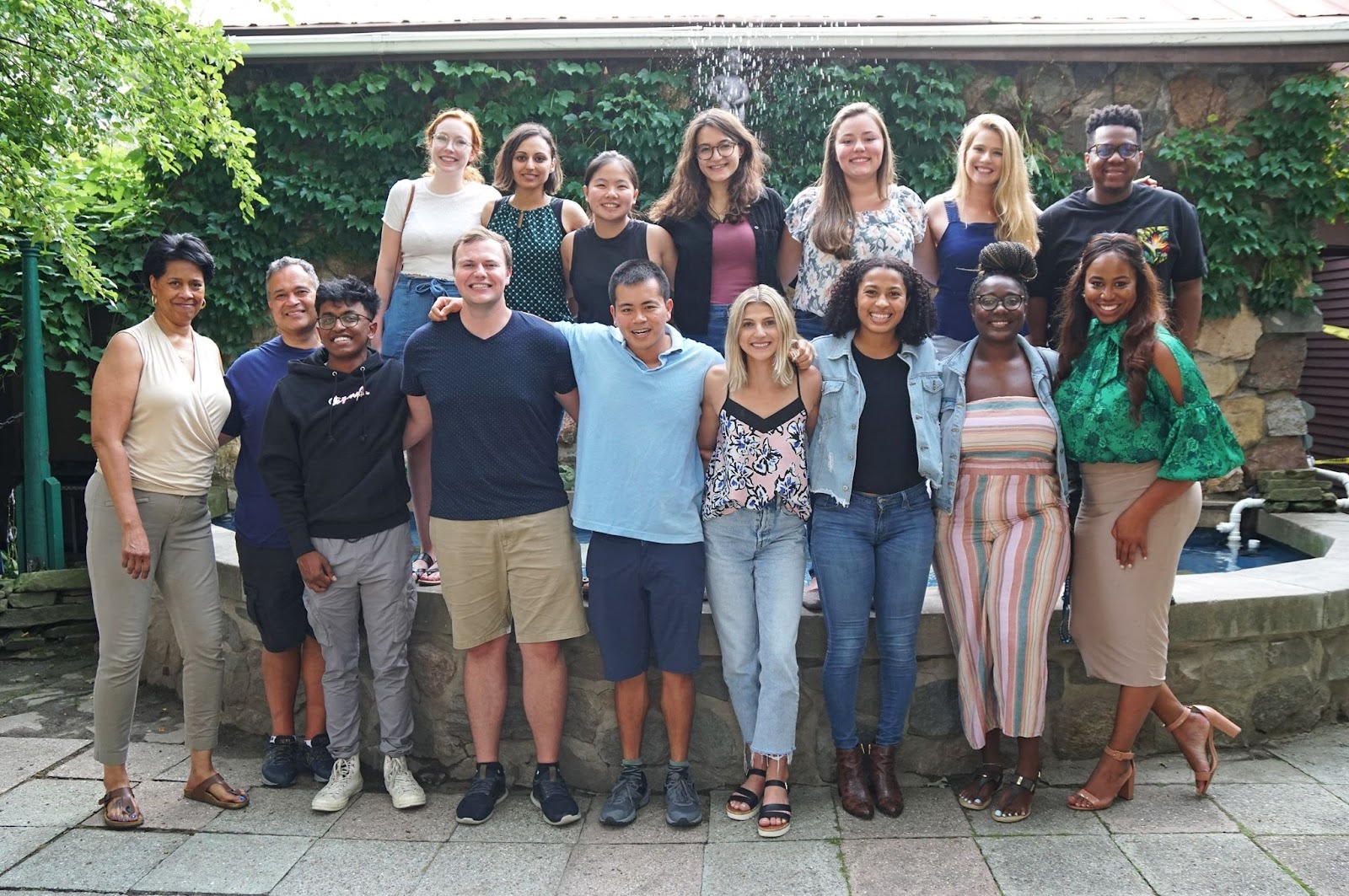
A few of us met for the first time in person at Dominick’s. After months of social distancing, we initially struggled to remember how to interact, but we managed to figure it out pretty quickly.
Through engaging presentations by faculty, staff, and guest speakers, we discussed topics such as finding mentorship, qualities of a great leader, and improving communication skills. Additionally, we engaged in difficult, but pertinent discussions on racism, microaggressions, and social determinants of health. We addressed student well-being, and the various mental health resources available to us, including M-Home counseling and peer support groups. Through LEAD, it quickly became clear to me that UMMS harnesses a unique culture of openness, promotes wellness, and actively implements new programs to support its diverse class of students.
“The LEAD program acted as a bridge to medical school. Michigan medical students come from all walks of life with gap years ranging from 0 to 2+ years. However, we all arrived here with a common identifier, as University of Michigan medical students. This sentiment was reinforced on the very first day of LEAD.”
–Oluwatomi ‘Tomi’ Lawal, M1
The LEAD program, which is usually held in person, was beautifully adapted for Zoom and vastly surpassed my expectations. My colleagues and I developed an instantaneous mutual respect and understanding with one another through sharing our stories and vulnerabilities. My personal lesson from LEAD is to have the courage to express my opinions on the off chance that there are others who feel the same way. Whether others are in agreement or not, it often leads to interesting discussions which fosters a deeper understanding for one another.
Now into my third week of medical school, I realize that the inclusivity I experienced is not unique to LEAD, rather it is a function of UMMS culture as a whole. As I think back to my virtual interview day, I distinctly remember a moment where Director Teener encouraged us to just be ourselves and to believe that our unique communication styles were exactly what UMMS is looking for. At this moment, fears melted into tears of joy, and set the tone for my entire experience so far. I am grateful to be a part of an institution, a family, that attracts culturally competent students from all walks of life, that celebrates our differences and our unique paths that have led us to this point.
On the first day of M1 Launch, Dean Gay welcomed us by exactly pinpointing our feelings of excitement, anxiousness, and fear (I managed to hold back my tears this time). He told us not to see one another as competition, but rather as inspiration. Inspiration to do better, to be better. As I look around at the amazing and resilient peers with whom I will experience my medical journey, whom I will learn from and grow with, it has become immensely clear to me that our diversity is our strength. It is what sets us apart. It is the very thing that will make us great future physician LEADers.















 Over the summer, I kept coming back to volunteer about once a week at the farm. My brother, an undergraduate at Michigan, also started joining me regularly, and this became our usual Monday evening ritual. I loved that we had this time to hang out with each other in the middle of our busy schedules. I also had a lot of fun getting to know the other “regulars” volunteering. We’d all swap stories about our lives, and I particularly loved hearing the ones about their grandkids’ latest shenanigans!
Over the summer, I kept coming back to volunteer about once a week at the farm. My brother, an undergraduate at Michigan, also started joining me regularly, and this became our usual Monday evening ritual. I loved that we had this time to hang out with each other in the middle of our busy schedules. I also had a lot of fun getting to know the other “regulars” volunteering. We’d all swap stories about our lives, and I particularly loved hearing the ones about their grandkids’ latest shenanigans!
